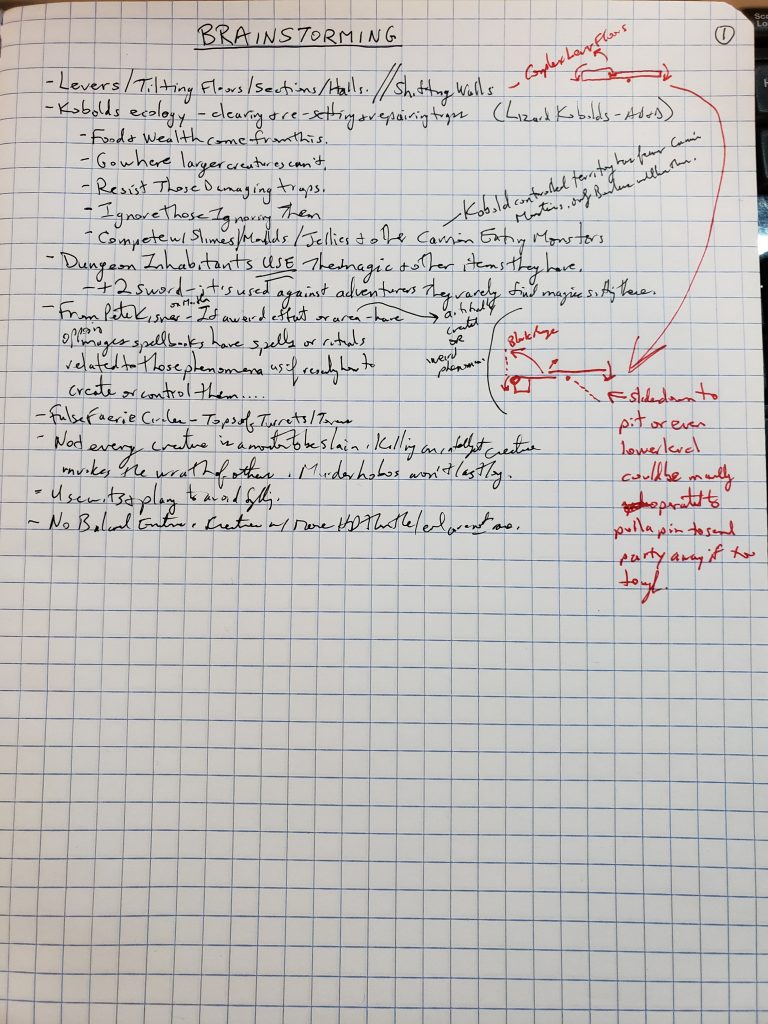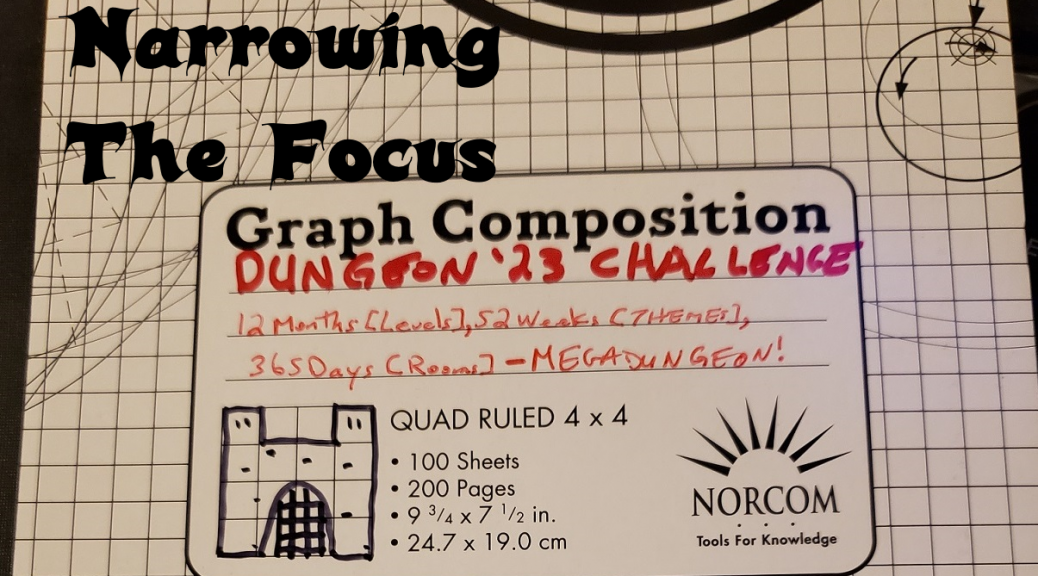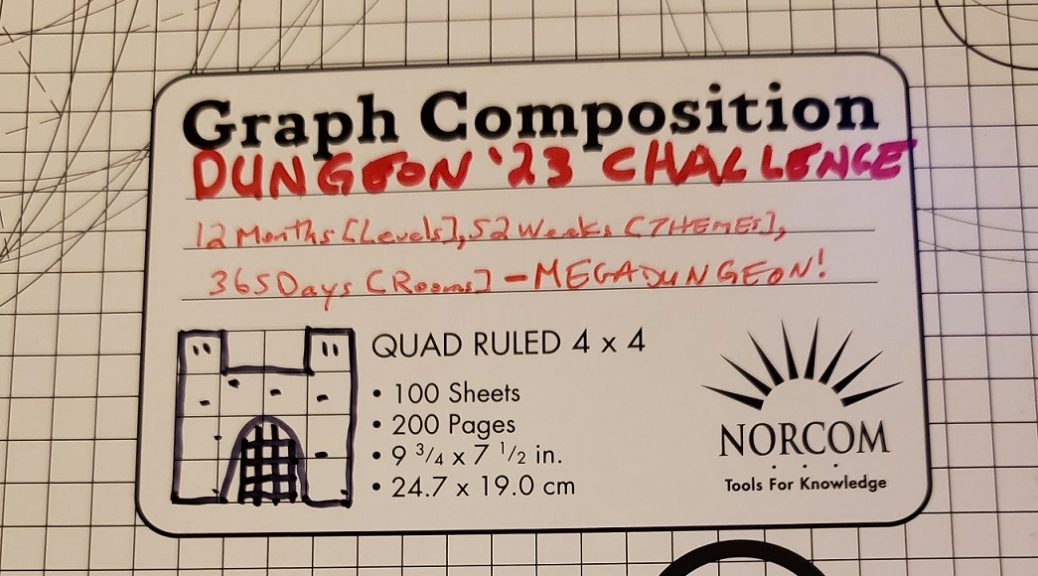I’ve decided to do the #Dungeon23 Challenge as I mentioned in my prior post where I describe what it is, resources some have suggested, and my own ideas about it.
The biggest issues after sticking with it for a year are narrowing the scope of the project so that it is manageable, and narrowing the scope to what resources one uses to generate the maps, select themes, and populate each room.
Some can just wing it and do it all off the top of their head. If I did that, it would be rather bland. I want something fun and interesting that others would want to use, whether in whole or in part.
For generating the dungeon, I’m thinking of the 1e DMG Random Dungeon Generation tables. At the least, I will use it to plan the entrances to the dungeon. I think having multiple levels have a connection to the surface, even if a convoluted connection, makes sense. Some of those connections would be how various creatures get into the dungeon to begin with.
I think there should be factions in the dungeon that control a section of a single level, or multiple levels along obvious stairwells, etc. Food, water, waste disposal, power, control (of areas, creatures, features, magic, etc.), alliances, absolute enemies, minions, lieutenants, and bosses, should all make sense. Just figuring out how all this works would be part of the adventure and exploration for a party of adventurers.
My Process
I’ve decided to stick with what I have and use a Graph Composition book for thee #Dungeon23 Challenge.
I have an index page and page 1 is for Brainstorming.

Using ideas I’ve scrawled in notebooks or written blog posts about or new ideas.
- Levers & tilting floors, sliding walls, etc. Both simple and complex traps. Some of which are not obvious to the trapped that they have been trapped.
- Kobolds as maintainer & re-setters of traps. They get food and wealth from traps. However, they compete with carrion eating monsters. Kobold controlled territory will have fewer carrion monsters.
Kobolds will ignore those who ignore them. - Magic and other items will be USED by dungeon dwellers. Adventurers will RARELY find magic items not being used.
- Not everything in the dungeon is a monster to be slain. Killing intelligent creatures will invoke the enmity of all the others against those responsible. Murder hobos will not last long.
- Using wits and planning and avoiding fighting as was the case with original D&D style of play will achieve better results. Only creatures of animal intelligence or truly evil intent will the party be at risk of a fight.
- Balanced encounters are not a thing. Creatures of more HD than the level of the dungeon will not be rare, especially near connections between levels. Factions that span multiple levels will project power in this way. Masses of low HD creatures will offset the advantages of multiple HD creatures, especially if the low HD creatures are cunning and cooperative.
- Various tricks and trap ideas I’ve written about on my blog or in various notebooks, but never used.
- Food, Water, and Waste – How do the dungeon inhabitants survive and not fill up the passageways with refuse?
- How do intelligent dungeon inhabitants make use of the unintelligent ones to maximize their strength and control of their territory?
- Creative encounter tables – See Nested/Dynamic Encounters below.
Deciding Which Resources To Use
There are far too many good resources to help generate and populate dungeons to just limit it to one resource. This includes manuals of both old and new games, gaming resources for such things, and so many blog posts over the years of OSR blogs about this very topic.
No one resource has everything I feel that I need for this. If I only had to pick one resource it would be the AD&D 1e DMG [Affiliate Link]. This would be Appendices:
- A – Random Dungeon Generation
- G – Traps
- H – Tricks
- I – Dungeon Dressing
- K – Describing Magical Substances
More Blog Articles On Megadungeons
Here is a collection of links to various blog posts about megadungeons. Some of them are collections of articles. Sadly, many old blogs and some articles are no more, not even on the Internet Archive’s Wayback Machine.
http://grognardia.blogspot.com/2009/02/old-school-dungeon-design-guidelines.html
http://thedragonsflagon.blogspot.com/2012/05/secret-door-triggers.html
http://therustybattleaxe.blogspot.com/2013/12/megadungeon-hall-of-fame-megadungeon.html
http://thedragonsflagon.blogspot.com/2014/01/keying-corridors.html
http://initiativeone.blogspot.com/2014/02/ready-reference-whats-blocking-corridor.html
http://9and30kingdoms.blogspot.com/2014/02/random-dungeon-musings.html
https://dungeonfantastic.blogspot.com/p/megadungeon-design.html
https://www.dragonsfoot.org/forums/viewtopic.php?f=42&t=27662
http://beyondtheblackgate.blogspot.com/search?q=megadungeon+design+and+philosophy
http://therustybattleaxe.blogspot.com/p/dungeon-links.html
http://therustybattleaxe.blogspot.com/p/megadungeon-links-ii-maps-tables.html
Dynamic/Nested Encounter Tables
This is a great idea that can be applied to dungeons, cities, and hexcrawls to make encounter tables generate more interesting results. Or use as a base to make custom encounter tables including those options. (Great for one shots and convention games, or modules.)
http://monstersandmanuals.blogspot.com/2011/10/dynamicnested-encounter-tables.html
http://www.welshpiper.com/dynamic-encounter-tables/#more-2342


